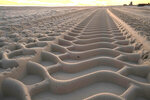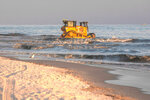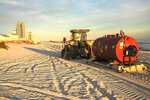Mere weeks after the city of Gulf Shores wrapped up phase one of the island's $17 million beach renourishment project, severe storms greeted the Gulf Coast with heavy rain and winds of up to 73 miles …
This item is available in full to subscribers.
Please log in to continue |








Mere weeks after the city of Gulf Shores wrapped up phase one of the island's $17 million beach renourishment project, severe storms greeted the Gulf Coast with heavy rain and winds of up to 73 miles per hour.
According to Brandan Franklin, chief building official for the city, there was some storm damage closer to the shoreline.
"There was some damage around the 900 and 1400 block of West Beach, where the storms effected several areas of the beach with high surf and wind that washed away several areas of sand," Franklin said.
Franklin said the city currently does not have plans to add more sand to the damaged areas.
"Once the contractor is finished, they aren't coming back, so it wasn't timely for Mother Nature to hit when she did," Franklin said. "The FEMA reimbursements have all been completed already, so to have them come back now would be out of the city's pocket."
However, there is a silver lining as Franklin said sand is typically redistributed during the spring, which will help to fill in some of the lost shore.
"What we typically see in the spring is that sand will be redistributed; it may not get to the same elevation, but we will see additional length of the dunes," Franklin said. "Had we not had additional sand there from the renourishment project, we would have lost more dunes and seen waves breaking on structures."
According to Franklin, the redistribution of sand is caused by southeastern predominant winds in March and April that push sand back to the shoreline.
"The city is as heartbroken as anybody," Franklin said. "But we had a similar situation when Hurricane Daley hit a few years ago, and by the next year the damaged parts were some of the widest areas."
Contractors began mobilizing equipment on Oct. 20 and are projected to complete the Gulf Shores portion in January before moving on to Gulf State Park, Orange Beach and Perdido Key.
The project crews will use two dredging vessels to distribute approximately 18,500 cubic yards of sand daily. Patrons can still access beach areas outside the work zone, and completed restoration areas and ramps will provide shoreline access over the pipes.
Per a July 2023 article from Gulf Coast Media, approximately 85-95% of the project costs should be reimbursed by FEMA and AEMA due to damage caused by Hurricanes Nate and Sally. After reimbursements, the city would owe approximately $6,579,242, which would be funded through the 2% lodging tax instituted to maintain the city's engineered beaches.
Between 2001 and 2004, the city invested approximately $18 million to construct the first engineered beach projects that are now recognized by FEMA as city infrastructure. As long as the city periodically reinvests in renourishment projects, damages due to a declared disaster are reimbursable by FEMA/AEMA.
The 405,000 cubic yards of additional sand included in the restoration work will insure the city maintains FEMA eligibility, provides greater storm protection, wider recreational beaches and extends the life cycle of our beach renourishment by approximately two years.